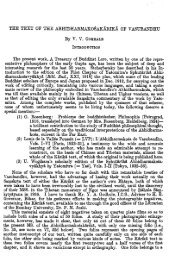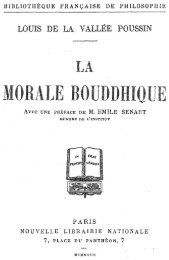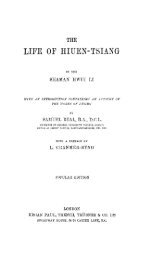La Vallée Poussin Musīla and Nārada. The Path - Gampo Abbey
La Vallée Poussin Musīla and Nārada. The Path - Gampo Abbey
La Vallée Poussin Musīla and Nārada. The Path - Gampo Abbey
You also want an ePaper? Increase the reach of your titles
YUMPU automatically turns print PDFs into web optimized ePapers that Google loves.
Musıla <strong>and</strong> N›rada. <strong>The</strong> <strong>Path</strong> of Nirv›˚a: by Louis de <strong>La</strong> <strong>Vallée</strong> <strong>Poussin</strong><br />
According to the Abhidharma, unless I am mistaken, these perfected beings possess at least the<br />
‘preparatory meditation’ (an›gamya), but usually possess the meditations (dhy›na): the equipoises<br />
that they lack are the four formless equipoises <strong>and</strong> the ‘equipoise of cessation’ (nirodhasam›patti).<br />
According to the Majjhima, I, 477, ‘those liberated through discrimination’ (paññ›vimutta) are the<br />
perfected beings who have not touched the calm formless liberations (or equipoises [of<br />
cessation]). <strong>The</strong>refore, it would seem, they possess the meditations (jh›na).<br />
But in the Puggalapaññatti, the perfected beings are those who have not touched the eight<br />
liberations [namely, the four meditations (jh›na) <strong>and</strong> the four formless equipoises].<br />
25 Visuddhimagga, 702: Ordinary persons (p¸thagjana), the noble persons (›rya) of the first two classes, the<br />
never-returners (an›gamin) <strong>and</strong> the perfected beings (arhat) of the sukkhavipassaka class, do not enter into the<br />
‘equipoise of cessation’ (nirodhasam›patti). <strong>The</strong> never-returners <strong>and</strong> the perfected beings who possess the<br />
eight equipoises (sam›patti) (four meditations, four formless equipoises) do enter into it, not the others.<br />
Compendium (transl. of the Abhidhammatthasa˚gaha, a treatise of the 10 th (?) century, in P.T.S., 1910, with<br />
good introduction by Shwe Zan Aung), 55: “…it must be borne in mind that jh›na is not absolutely necessary<br />
to Arahantship, as e.g., in the case of the Arahants termed ‘dry-visioned’ (sukkhavipassak›)”; Childers, s.v.,<br />
samatha: the Arahant of this class is so called because he attains sanctification by contemplating the ‘dry’<br />
facts of physical <strong>and</strong> moral phenomena, such as impermanence, etc. – Geiger, transl. of Sa˙yutta, II, 172,<br />
which I [LVP] have not seen.<br />
14






